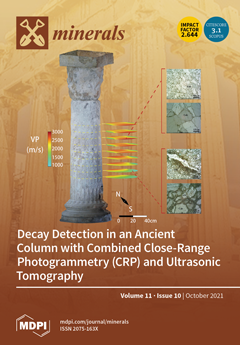The uptake of beryllium by hardened cement paste (HCP, with CEM I 42,5 N BV/SR/LA type) in degradation stage I was investigated with a series of batch sorption experiments with 10
−6 M ≤ [Be(II)]
0 ≤ 10
−2.5 M and 2 g·L
[...] Read more.
The uptake of beryllium by hardened cement paste (HCP, with CEM I 42,5 N BV/SR/LA type) in degradation stage I was investigated with a series of batch sorption experiments with 10
−6 M ≤ [Be(II)]
0 ≤ 10
−2.5 M and 2 g·L
−1 ≤ [S/L] ≤ 50 g·L
−1. All experiments were performed under Ar atmosphere at
T = (22 ± 2) °C. Solubility limits calculated for α-Be(OH)
2(cr) in the conditions of the cement pore water were used to define the experimental window in the sorption experiments. Beryllium sorbs strongly on HCP under all of the investigated conditions, with log R
d ≈ 5.5 (R
d in L⋅kg
−1). Sorption isotherms show a linear behavior with a slope of ≈+1 (log [Be(II)]
solid vs. log [Be(II)]
aq) over four orders of magnitude (10
−8 M ≤ [Be(II)]
aq ≤ 10
−4 M), which confirm that the uptake is controlled by sorption processes and that solubility phenomena do not play any role within the considered boundary conditions. The similar uptake observed for beryllium in calcium silicate hydrate (C-S-H) phases supports that the C-S-H phases are the main sink of Be(II) in cement. The strong uptake observed for Be(II) agrees with the findings reported for heavier metal ions, e.g., Zn(II), Eu(III), Am(III), or Th(IV). The exceptional sorption properties of beryllium can be partially explained by its small size, which result in a charge-to-size ratio (z/d) of the same order as Eu(III) or Am(III). Kinetic experiments confirm the slow uptake of Be(II), which is characterized by a two-step process. In analogy to other strongly sorbing metal ions such as Zn(II) or Th(IV), a fast surface complexation (
t < 4 days) followed by a slower incorporation of Be(II) in the C-S-H structure (
t ≥ 60 days) are proposed. The surface complexation was studied in detail with molecular dynamic simulations, and the most common surface species are identified and described. This work provides the first experimental evidence supporting the strong uptake of Be(II) by HCP in degradation stage I, further extending previous findings on C-S-H phases and HCP in degradation stage II. These results overcome previous conservative estimates assuming no or only a weak uptake in cementitious systems and represent a relevant contribution for the quantitative assessment on the retention/mobilization of beryllium in the context of nuclear waste disposal.
Full article





